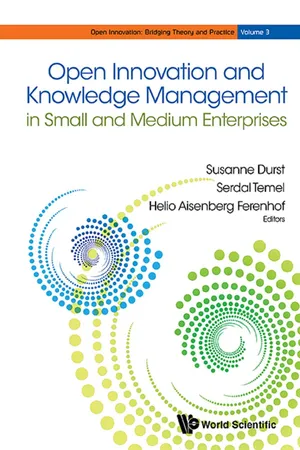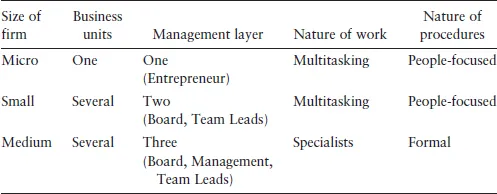
Open Innovation and Knowledge Management in Small and Medium Enterprises
- 244 pages
- English
- ePUB (mobile friendly)
- Available on iOS & Android
Open Innovation and Knowledge Management in Small and Medium Enterprises
About this book
-->
The book studies the interplay between open innovation and knowledge management issues in small and medium-sized enterprises (SMEs). With the proliferation of the open innovation paradigm and against the backdrop of increasing external knowledge transfer activities, knowledge management is more important than ever for innovation and firm performance of any type of organization. In fact, knowledge management is no longer a pure intra-organizational activity but constitutes a vital interface function between the organization and its external partners/stakeholders.
Throughout the book, readers will obtain both a broad overview of the two main concepts namely open innovation and knowledge management and its interplay. In addition, research will be presented which will help the readers to develop and/or expand their understanding of the phenomenon. This broad approach can also support in broadening the mindset regarding the topic under investigation and its application. Thereby, this book will primarily focus on SMEs and their approach with respect to the interplay in question.
In order to achieve the above-mentioned aim, the book consists of ten chapters that are assigned to three parts. Part 1 introduces to the main concepts, namely, SMEs, Open Innovation, Knowledge Management, and the interplay between open innovation and knowledge management in SMEs. This is followed by Part 2, which provides empirical research insights into the phenomenon of interest. The book concludes with Part 3 which addresses promising future avenues regarding the study of open innovation and knowledge management in SMEs. All the chapters are written by leading international researchers in the respective fields, which makes the book a unique piece of work.
--> Contents:
- Preface
- About the Editors
- About the Contributors
- Introduction (Susanne Durst, Serdal Temel, and Helio Aisenberg Ferenhof)
- Introduction to Main Concepts:
- Small and Medium-sized Enterprises (SMEs) (Thomas Henschel and Ilka Heinze)
- The Concept of Open Innovation (Ilker Murat Ar)
- Knowledge Management (Helio Aisenberg Ferenhof)
- The Interplay between Open Innovation and Knowledge Management in SMEs (Serdal Temel and Susanne Durst)
- Research Insights:
- Knowledge Creation and Open Innovation in High-Technology SMEs (Elsa Grimsdottir and Ingi Runar Edvardsson)
- Knowledge Sharing and Open Innovation (Ardalan Haghighi Talab, Victor Scholten, and Cees van Beers)
- Comparing Open Innovation of Innovative Food SMEs with SMEs in the Seed and High-Tech Industries — An Analysis of 15 SMEs in the Netherlands (Onno Omta, Frances Fortuin, and Niels Dijkman)
- ALITE: Open Innovation and Experimentation in a Small Learning Organization (Joaquín Alegre, Francisco Romera, Ana García-Granero, and Anabel Fernández-Mesa)
- Mitigation of Knowledge Risks in Open Innovation (Haley Wing Chi Tsang and Rongbin W B Lee)
- The Future:
- Open Innovation and Knowledge Management in SMEs: What Comes Next? (Susanne Durst and Serdal Temel)
- Index
-->
--> Readership: Graduate students and researchers in the fields of open innovation and knowledge management. -->
Keywords:Open Innovation;Knowledge Management;Innovation Management;Small and Medium-Sized Enterprises;SMEs;Small FirmsReview:
"Open innovation in SMEs has not received yet the attention it deserves. This edited volume explores open innovation and knowledge management in small and medium-sized companies. I highly recommend this book to anyone interested in the unique characteristics of open innovation management in small companies."
Wim Vanhaverbeke
Professor, Hasselt University;
Visiting Professor, ESADE and National University of Singapore
"This is a timely book; the fields of knowledge management and open innovation are growing fast, reflecting their rising importance for competitive success.
This book brings together leading scholars studying knowledge management, open innovation and their intersection. They advance new ideas and frameworks that will inspire insightful future research and managerial action. I highly recommend it."
Shaker A Zahra
Professor & Department Chair
University of Minnesota
"Open innovation is one of the great advances in society whose potential is just now being recognized. The editors and authors have pioneered bringing this important topic into the domain of SMEs. This book will set the strong foundation for future investigation that scholars will consistently refer as we move forward."
Garry D Bruton
Texas Christian University
Key Features:
- Unique treatment of addressing the interface between open innovation and knowledge management from a SME point of view
- Contributions from authors from different parts of the world
Frequently asked questions
- Essential is ideal for learners and professionals who enjoy exploring a wide range of subjects. Access the Essential Library with 800,000+ trusted titles and best-sellers across business, personal growth, and the humanities. Includes unlimited reading time and Standard Read Aloud voice.
- Complete: Perfect for advanced learners and researchers needing full, unrestricted access. Unlock 1.4M+ books across hundreds of subjects, including academic and specialized titles. The Complete Plan also includes advanced features like Premium Read Aloud and Research Assistant.
Please note we cannot support devices running on iOS 13 and Android 7 or earlier. Learn more about using the app.
to Main Concepts
†School of Management and Organizational Science, Kaposvár University, P.O. Box 16, H-7400 Kaposvár, Guba Sándor U. 40, Hungary

Table of contents
- Cover Page
- Title
- Copyright
- Dedication
- Preface
- About the Editors
- About the Contributors
- Contents
- Introduction
- Part 1 Introduction to Main Concepts
- Part 2 Research Insights
- Part 3 The Future
- Index